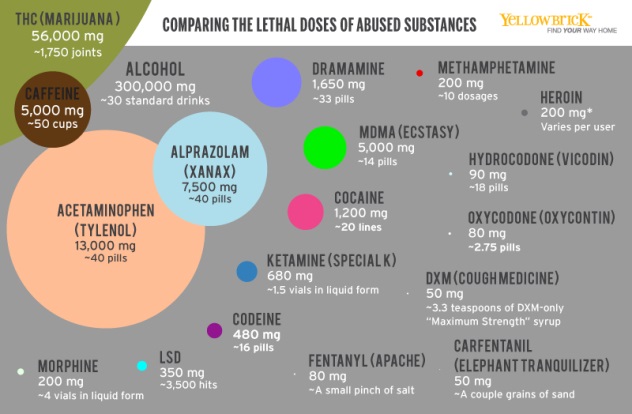*Elephant is not your doctor or hospital. Our lawyers would say “this web site is not designed to, and should not be construed to provide medical advice, professional diagnosis, opinion or treatment to you or any other individual, and is not intended as a substitute for medical or professional care and treatment. Always consult a health professional before trying out new home therapies or changing your diet.” But we can’t afford lawyers, and you knew all that. ~ Ed.
~
Substances abuse and addiction is no joke.
Many people deal with this in their lives, whether it’s on a personal level, or from a close family member or friend.
Alcoholism runs on my father’s side of the family, so I’ve dealt with watching close family members struggle with addiction from a very young age.
I’ve watched a family member—who I was close with—drink himself to death slowly over the course of 20 years. While I have fond memories of our time together, I also can’t recall a time when he didn’t smell like vodka, even when he claimed to be off the sauce.
He would often go away for months at a time, and while I assumed he was always traveling for work, the truth of the matter is that he was often in and out of jail because of his problems with addiction and alcohol abuse.
These interactions impacted my views on alcoholism and addiction at an early age. I learned that those who struggle with addiction problems will often lean on denial as a defense mechanism and that they need to hit rock bottom before they address their problem. Rock bottom, for many, means overdosing on their substance of choice.
Data from the National Institute on Drug Abuse shows that on average, 125 Americans overdose each day.
Deaths from drug overdose continue to rise in nearly every county across the United States, largely fueled by the rise of addiction to painkillers, heroin, and fentanyl.
One of the main causes of accidental overdose is a lack of education about how much of a certain substance is too much. In the instance of fentanyl, 80 mg—equivalent to a small pinch of salt—can be deadly.
Education is one way that we can work together to prevent accidental overdose deaths. To help educate the general public on the lethal doses of commonly abused substances, Yellowbrick treatment facility created a graphic that shows—at scale—the lethal doses of a large variety of legal and illegal substances.

Some of the lethal doses aren’t surprising.
Most people are familiar with alcohol poisoning. 300,000 mg or 30 standard drinks would be considered deadly. I think it’s safe to assume that most know that consuming 30 drinks in one sitting is a bad idea.
There are, however, other examples that are much less obvious. Take DXM (cough medicine), where only 50 mg or 3.3 teaspoons would lead to death. Oxycodone is another less obvious example where just under three pills could be deadly.
Keep in mind that it’s not always easy to identify a drug emergency or overdose. A drug overdose can happen no matter the substance, frequency of use, or even the amount taken. A drug overdose is an extremely dangerous situation and requires quick thinking and action.
If you suspect a family or friend of overdosing, the first step is to call 911 or poison control at 800-222-1222 immediately.
Don’t worry that the person overdosing may be upset with you, or about the consequences of taking the substance. The most important thing is to save their life.
If the person has stopped breathing or collapsed, begin CPR if necessary.
Collect any drugs, pills, or alcohol that have been taken to bring to the emergency room so that doctors and nurses have an idea of what has been ingested.
Any information you can provide about the type of drug taken and the person’s underlying medical problems (if any) will be helpful to the person treating your loved one and can help to save their life.
Another way to prevent a potential overdose is by taking proactive steps to help someone dealing with addiction before their problem turns serious. If you suspect someone may be at risk of addiction, follow these steps to help them address their problem:
1. Get educated. We can’t help fight addiction if we don’t understand the problem. Learn about the signs, treatments, and relapse triggers. Both WebMD and MedicalNewsToday have comprehensive resources related to identifying the signs and symptoms of addiction.
2. Talk about it. Talking about the problem is important. Addiction can’t be treated if it’s an elephant in the room. A person dealing with addiction may hesitate to reach out and ask for help, and it can be hard to know what to say. This is a time when that person needs help the most. Just don’t try and talk to them when they are on the substance in question. And don’t worry about saying things perfectly—the most important thing is expressing your concern in a caring and honest way.
3. Practice acceptance. Many people dealing with addiction feel judged by families and friends about their problem. Refrain from criticism and negativity when possible. Accept them for who they are and don’t be quick to judge.
4. Suggest treatment options or a support group. Support groups are a good idea and people struggling with addiction can interact with others who are dealing with the same issues. Alcoholics Anonymous (AA) and Narcotics Anonymous (NA) are free support groups that have helped thousands of people to beat and better live with their addiction. For more professional treatment options, a simple Google search of treatment facilities nearby can help you locate a professional in your area.
5. Realize that you can’t make someone quit. Your loved one may not be ready to accept help. You can have an intervention and force someone to get treatment, but you can’t make someone get and stay sober. They have to make that decision in their own time, and of their own will. Many popular treatment programs will say the first step to recovery is for the addict to admit that they have a problem. Once that step is taken, recovery can truly be begin.
~
Author: Matt Zajechowski
Images: St. Albert/Flickr; Yellowbrick
Editor: Catherine Monkman

 Share on bsky
Share on bsky





Read 0 comments and reply